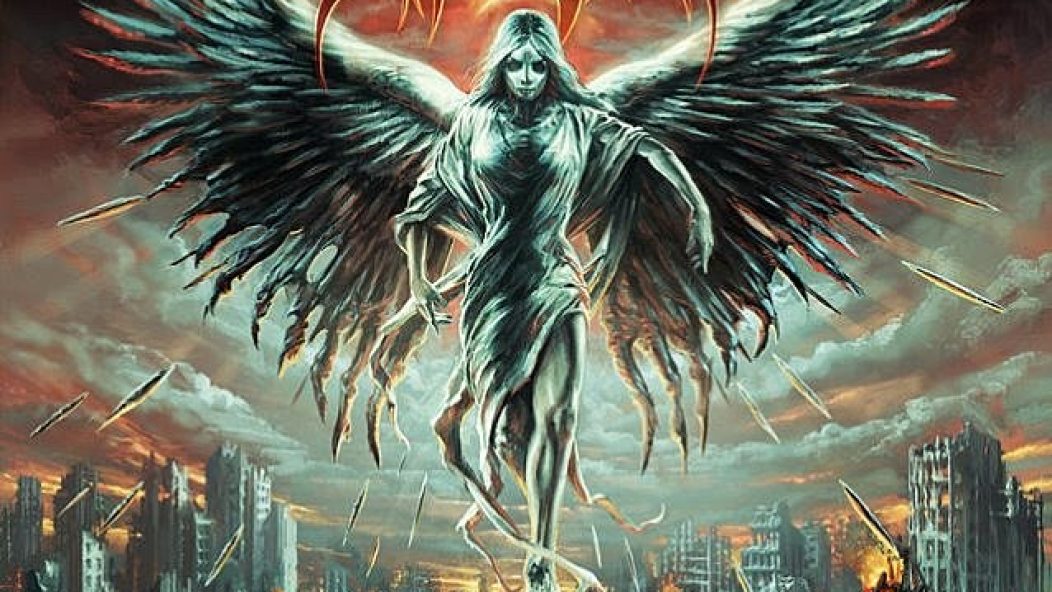
How Immolation Writes a Song

…
Last Friday, New York death metal outfit Immolation released their new album, Atonement. It’s very good, which should come as no surprise. Immolation usually write very good albums that all sort-of sound the same. Their goodness is connected to their sameness. Immolation have a fairly unique style that draws from a handful of basic songwriting techniques. What makes the band so good, is that they marry these techniques to the individual strengths of their members to create a distinct style.
Immolation create more space in their songs than most death metal bands do. They’re not often silent, but the instruments rarely all draw attention to themselves at once, so listeners can clearly focus on one thing at a time.
…
…
In “Destructive Currents”, the first single from Atonement, Immolation introduces the song’s first theme before Ross Dolan’s vocal part enters, so that the listener has a chance to absorb the riff first and then focus on the vocal line and its lyrics second. When Immolation introduces the second riff about 1:00 in, the lead melody, rhythm guitar, bass and drums all enter one after the other. Each piece has a chance to be absorbed before another instrument can overpower it.
Dolan’s fairly monotone vocals don’t reach into a high register, so that even when he’s singing at the same time as an interesting guitar line such as the song’s chorus, he’s never encroaching on the lead guitar’s space. A person can listen to the song for Dolan’s voice, or for Vigna’s lead guitar and easily fixate on either, while the other section of the song remains audible in the background.
Immolation owe much of their songwriting clarity to drummer Steve Shalaty, who always drums around the remaining parts of the song, not through them. He plays in unison with the guitar and bass on the first section of “Destructive Currents”, but in the second section from 1:05 onward, his snare hits start to dance around the beat. That riff has a more complex guitar line, which makes more use of Vigna’s pinch harmonic notes. Those notes all exist in the upper register of the sound next to the cymbals, so when Shalaty lays off the copper – or, in this instance, starts hitting a china – Vigna’s harmonics have more room to shine. When he hits a cymbal in this section, the hits decay quickly. They are punctuation marks not words.
…
…
The rest of the band gives Shalaty room, too. His drums occupy most of the space in the intro to “Fostering the Divide”. His drumline is busy, but it’s played softly and texturally enough that it doesn’t interfere with the guitars and bass when they do enter. Later in the song, when all the instruments are firing at once they keep out of one another’s way, and the production keeps them well separated.
Shalaty’s hits remain fast and precise, but not all the time. When he plays he plays hard, but during the riff at about 40 seconds into the song, he quiets down at the same time as the stringed instruments, and that negative space creates tension that underpins Dolan’s vocals.
“Fostering the Divide” is also a great example of the songwriting technique that Immolation use best: call and response. One instrument prompts a response by another. In the intro to “Fostering the Divide”, palm muted guitar chugs posit a question, andShalaty’s high speed fills answer.
…
…
Call and response works on a basic neurological level because it mirrors the way human beings talk. We are hardwired to react to sonic patterns like this. The patterns works so well in this song because it repeats in later sections, and likewise the deviated nature of most of the riffs dovetails with the song’s lyrical theme of the divisions between people and their attacks on one another.
…
…
In the above video posted to the band’s Facebook, bassist Ross Dolan and guitarist Bob Vigna touch on a few of the songwriting techniques they employ but focus mostly on the song’s extended tremolo picked solo section. It’s a great section, but only has weight because it’s preceded by the extended call and response part of the song, which shows up again at the end as a refrain.
Call and response is nothing new to Immolation. Vigna often uses it in his riffs in order to maximize the impact of his pinch harmonics. Many metal riffs consist of two pieces: a bottom string chug, followed by a flourish played either higher on the neck of the guitar, or on higher strings. It’s in the chorus riff of Judas Priest’s “Breaking the Law”, for one example.
…
…
Judas Priest also use a vocal call and response to underpin the two pieces of the verse riff of “Living After Midnight”. Call: “I took the city ‘bout one a.m.” Response: “Loaded, loaded.” They do this again in the bridge, with the guitars as the response to Halford’s call of “I’m aiming for ya” and “I’m gonna floor ya” etc.
…
…
Vigna, though doesn’t need to use vocals to underpin his riffs. His pinch harmonics, present in his playing since the first Immolation album Dawn of Possession have a different enough timbre from his distorted low note tone that his riffs often call and respond inside themselves. For a straightforward example of this, Vigna uses the chug-then-pinch mechanic in the riff about 1:00 into “A Glorious Epoch” from Majesty and Decay.
…
…
Call and response and negative space are basic musical concepts. Any basic songwriting course at a high school or community college ought to cover them in a few weeks. But these are basics for a reason: they propel songs forward, give musical ideas structure, and draw listeners in. Immolation remember their basics where too many other bands are content to play with as much intensity as they can for the entire duration of a song. Mastering these basics makes Atonement one more triumph in a career full of them.
…
…











